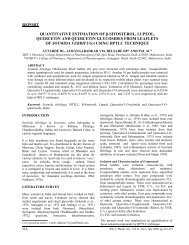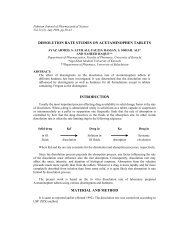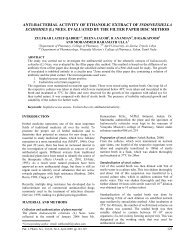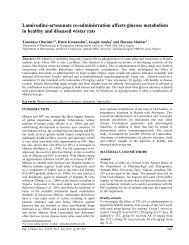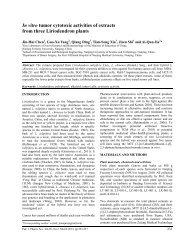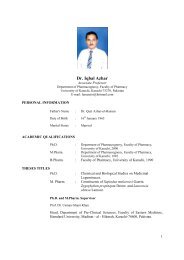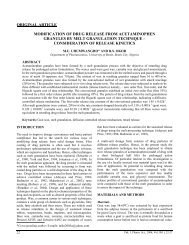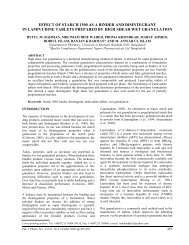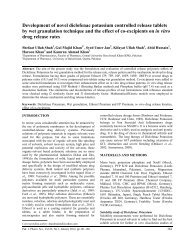Identification of Sulfamoylbenzamide derivatives as selective ...
Identification of Sulfamoylbenzamide derivatives as selective ...
Identification of Sulfamoylbenzamide derivatives as selective ...
Create successful ePaper yourself
Turn your PDF publications into a flip-book with our unique Google optimized e-Paper software.
<strong>Identification</strong> <strong>of</strong> <strong>Sulfamoylbenzamide</strong> <strong>derivatives</strong> <strong>as</strong> <strong>selective</strong><br />
Cathepsin D inhibitors<br />
W<strong>as</strong>eem Ahmed *1,2 , Ishtiaq Ahmad Khan 1 , Muhammad Nadeem Arshad 3 ,<br />
W<strong>as</strong>eeq Ahmad Siddiqui 3 , Muhammad Abdul Haleem 4 and Muhammad Kamran Azim 1<br />
1 Dr. Panjwani Center for Molecular Medicine and Drug Research, ICCBS, University <strong>of</strong> Karachi, Karachi, Pakistan<br />
2 Department <strong>of</strong> Biochemistry, Fed. Urdu Univ. <strong>of</strong> Arts Sci. & Tech., Gulshan-e-Iqbal Campus, Karachi, Pakistan<br />
3 GC University, Ketchery Road, Lahore, Pakistan<br />
4 Department <strong>of</strong> Biomedical Engineering, Sir Syed University <strong>of</strong> Technology, Karachi, Pakistan<br />
Abstract: Aspartic prote<strong>as</strong>es play very important role in post translational processing <strong>of</strong> proteins and several <strong>of</strong> them are<br />
essential for organism’s viability. Here we present the enzyme inhibition activities <strong>of</strong> different <strong>Sulfamoylbenzamide</strong><br />
<strong>derivatives</strong> against two <strong>as</strong>partic prote<strong>as</strong>es cathepsin D and pl<strong>as</strong>mepsin II. Cathepsin D is an <strong>as</strong>partic prote<strong>as</strong>e that<br />
degrades proteins at acidic pH in the lysosomes, or extracellular matrix. It is overexpressed by epithelial bre<strong>as</strong>t cancer<br />
cells and hence hyper-secreted. On the other hand pl<strong>as</strong>mepsin II is an essential enzyme <strong>of</strong> Pl<strong>as</strong>modium falciperum.<br />
Cathepsin D and Pl<strong>as</strong>mepsin II are pivotal drug targets for treatment <strong>of</strong> bre<strong>as</strong>t cancer and malaria respectively. Virtual<br />
screening <strong>of</strong> <strong>Sulfamoylbenzamide</strong> compounds followed by enzyme inhibition <strong>as</strong>says revealed these compounds <strong>as</strong><br />
<strong>selective</strong> Cathepsin D inhibitors while inactive against Pl<strong>as</strong>mepsin-II. IC50 values <strong>of</strong> five <strong>Sulfamoylbenzamide</strong><br />
compounds tested are in range <strong>of</strong> 1.25-2.0 μM. N-(3-chlorophenyl)-2-sulfamoylbenzamide is identified <strong>as</strong> the most<br />
potent <strong>of</strong> all tested <strong>Sulfamoylbenzamide</strong> compounds with IC50 1.25 μM. It w<strong>as</strong> also noted that the docking score<br />
<strong>of</strong> theses compounds w<strong>as</strong> better in c<strong>as</strong>e <strong>of</strong> Cathepsin D <strong>as</strong> compared to Pl<strong>as</strong>mepsin-II. Docking score ranges from<br />
-29.9±1.16 to -35.1±0.13 in c<strong>as</strong>e <strong>of</strong> Cathepsin D, while from -24.0±0.10 to -29.5±0.10 in c<strong>as</strong>e <strong>of</strong> Pl<strong>as</strong>mepsin-II.<br />
Keywords: Aspartic prote<strong>as</strong>es, Cathepsin D, Pl<strong>as</strong>mepsin-II, enzyme inhibition.<br />
INTRODUCTION<br />
Prote<strong>as</strong>es control several key functions <strong>of</strong> cells such <strong>as</strong><br />
extrav<strong>as</strong>ation, inv<strong>as</strong>ion, motility, proliferation and<br />
met<strong>as</strong>t<strong>as</strong>is (Smith and Marshall 2010; Roy et al., 2009;<br />
Palermo and Joyce 2008). Among these, cathepsin<br />
prote<strong>as</strong>es play main regulatory role <strong>as</strong> the factor-binding<br />
proteins and growth factors and their receptor activities<br />
have a major biological function in development <strong>of</strong><br />
human colorectal cancer (Sakkiah et al., 2012., M<strong>as</strong>son et<br />
al., 2010; Rawlings and Barrett, 1993). Human cathepsin<br />
D is an <strong>as</strong>partic prote<strong>as</strong>e which functions at acidic pH<br />
extracellularly in the matrix or lysosomes. It have been<br />
demonstrated by several studies that Cathepsin D affects a<br />
range <strong>of</strong> steps in tumor met<strong>as</strong>t<strong>as</strong>is and progression. It<br />
stimulates cancer cell growth by tumor angiogenesis<br />
stimulating fibrobl<strong>as</strong>t growth factors (Benes et al., 2008;<br />
M<strong>as</strong>son et al., 2010). Endosomes and lysosomes retain<br />
Cathepsin D in normal cells but in bre<strong>as</strong>t cancer cells it is<br />
over expressed and hyper-secreted by epithelial bre<strong>as</strong>t<br />
cells (Liaudet-Coopman et al., 2006, Azim et al., 2008;<br />
G<strong>as</strong>parini 1998). Consequently degradative capacities <strong>of</strong><br />
these cells are changed along with accumulation <strong>of</strong><br />
Cathepsin D in the tumor microenvironment. Lysosomal<br />
Cathepsin D is secreted into the cytosol during apoptosis,<br />
where it may interact with and/or cleave nuclear anti-<br />
*Corresponding author: e-mail: Hw<strong>as</strong>t_9@hotmail.com<br />
Pak. J. Pharm. Sci., Vol.26, No.4, July 2013, pp.687-690<br />
apoptotic or pro-apoptotic proteins. During the resolution<br />
<strong>of</strong> inflammatory responses, neutrophils rapidly undergo<br />
apoptosis. A direct and f<strong>as</strong>t activation <strong>of</strong> c<strong>as</strong>p<strong>as</strong>e-8 by<br />
cathepsin D h<strong>as</strong> been shown to be crucial in the initial<br />
steps <strong>of</strong> neutrophil apoptosis (Conus et al., 2012).<br />
The pl<strong>as</strong>mepsin family <strong>of</strong> Pl<strong>as</strong>modium <strong>as</strong>partic prote<strong>as</strong>es<br />
is involved in haemoglobin degradation during the intraerythrocyte<br />
ph<strong>as</strong>e <strong>of</strong> malarial infection (Ersmark et al.,<br />
2006). Pl<strong>as</strong>mepsins have been considered <strong>as</strong> promising<br />
target for new anti-malarial drugs (Ahmad et al., 2010).<br />
The bilobal structure <strong>of</strong> Cathepsin D and pl<strong>as</strong>mepsin II<br />
prote<strong>as</strong>es contain predominantly b-sheets with small ahelical<br />
segments. The active site is located at the interface<br />
between the two domains encloses two invariant<br />
<strong>as</strong>partates. Despite the structural similarities among the<br />
members <strong>of</strong> <strong>as</strong>partic prote<strong>as</strong>es they have for less sequence<br />
similarities. For example, Cathepsin D exhibits about<br />
35% sequence homology to Pl<strong>as</strong>mepsins (Schechter and<br />
Berger 1967; Silva et al., 1996).<br />
Benzenesulfonamide <strong>derivatives</strong> have a great potential for<br />
medicinal applications (Ashraf et al., 2012; Siddiqui et<br />
al., 2012, Siddiqui et al., 2010, Siddiqui et al., 2008,<br />
Siddiqui et al., 2007). The sulfamoylbenzamide<br />
compounds are agonists and modulating ligands <strong>of</strong><br />
cannabinoid receptors. These compounds are considered<br />
687
<strong>Identification</strong> <strong>of</strong> <strong>Sulfamoylbenzamide</strong> <strong>derivatives</strong> <strong>as</strong> <strong>selective</strong> Cathepsin D inhibitors<br />
Table 1: Docking scores and inhibition data <strong>of</strong> selected <strong>Sulfamoylbenzamide</strong> compounds<br />
W-5<br />
688<br />
Compd. ID Structure<br />
O<br />
N<br />
H<br />
OH<br />
O<br />
O<br />
S<br />
O<br />
NH2 3-(2-sulfamoylbenzamido)benzoic acid<br />
H<br />
N<br />
N<br />
W-7 S<br />
O<br />
O<br />
N-benzyl-1,2-benzothiazol-3-amine 1,1-dioxide<br />
O<br />
W-24<br />
W-28<br />
W-30<br />
N<br />
H<br />
S NH<br />
Cl<br />
2<br />
O<br />
O<br />
N-(3-chlorophenyl)-2-sulfamoylbenzamide<br />
Docking in CD<br />
(FlexX score)<br />
useful for g<strong>as</strong>trointestinal disorders, inflammation, autoimmune<br />
dise<strong>as</strong>es, ischemic conditions, immune-related<br />
disorders, hyper-tension and neurological disorders.<br />
During the course <strong>of</strong> present studies, ligand docking <strong>of</strong><br />
several <strong>Sulfamoylbenzamide</strong> <strong>derivatives</strong> into the<br />
substrate-binding clefts <strong>of</strong> Pl<strong>as</strong>mepsin-II from<br />
Pl<strong>as</strong>modium falciparum and human cathepsin D h<strong>as</strong> been<br />
N<br />
H<br />
S NH2 O<br />
O<br />
N-(2,6-dimethylphenyl)-2-sulfamoylbenzamide<br />
O<br />
NH<br />
S NH2 O<br />
O<br />
N-(pyridin-2-yl)-2-sulfamoylbenzamide<br />
CD= human cathepsin D; PII= Pl<strong>as</strong>mepsin II<br />
cathepsin D inhibition (%)<br />
80<br />
70<br />
60<br />
50<br />
40<br />
30<br />
20<br />
10<br />
0<br />
N<br />
Inhibition <strong>of</strong> CD<br />
(IC50 in µM)<br />
Docking in PII<br />
(FlexX score)<br />
-32.5±0.20 2.0±0.10 -27.9±0.10<br />
Inhibtion <strong>of</strong> PII<br />
(IC50 in µM)<br />
Not active<br />
-35.1±0.13 2.0±0.13 -29.5±0.10 Not active<br />
-30.0±0.10 1.25±0.08 -26.1±0.15 Not active<br />
-30.9±0.13 1.5±0.08 -24.0±0.10 Not active<br />
-29.9±1.16 1.5±0.05 -26.9±0.10 Not active<br />
cathepsin D inhibition by <strong>Sulfamoylbenzamide</strong> compounds<br />
w4 w7 w24 w28 w30<br />
0 0.5 1 1.5<br />
Inhibitor concentration (Micromol)<br />
Fig. 1: Human cathepsin D inhibition plots <strong>of</strong> <strong>Sulfamoylbenzamide</strong> compounds.<br />
carried out. Enzyme inhibition <strong>as</strong>says were also<br />
performed using top scoring compounds from virtual<br />
screening. Interestingly, enzyme inhibition results showed<br />
that Sulfa-moylbenzamide compounds are <strong>selective</strong><br />
inhibitors <strong>of</strong> human cathepsin D and not active against<br />
Pl<strong>as</strong>mepsin II.<br />
Pak. J. Pharm. Sci., Vol.26, No.4, July 2013, pp.687-690<br />
2
MATERIALS AND METHODS<br />
In this study, virtual screening cum enzyme inhibition<br />
<strong>as</strong>say w<strong>as</strong> carried out to find the potent inhibitors <strong>of</strong><br />
Pl<strong>as</strong>mepsin II and Cathepsin D.<br />
Molecular docking<br />
FlexX ligand docking s<strong>of</strong>tware (version 2.0) ( Rarey et al.<br />
1996) w<strong>as</strong> utilized for docking using Pepstatin-A<br />
complexed crystal coordinates <strong>of</strong> cathepsin D and<br />
pl<strong>as</strong>mepsin-II (Silva et al, 1996) (Baldwin et al. 1993;<br />
Metcalf and Fusek 1993) (PDB id; 1M43 and 1LYB<br />
respectively). FlexX ligand docking method is b<strong>as</strong>ed on<br />
incremental construction <strong>of</strong> ligand molecules from<br />
smaller fragments in the cavity <strong>of</strong> a protein. The free<br />
binding energy (∆G) <strong>of</strong> protein-ligand complex is utilized<br />
to rank the generated docking results using a scoring<br />
function similar to that developed by Bohm (Bohm 1994).<br />
After completion <strong>of</strong> each docking experiment, top ten<br />
docking solutions were saved and utilized for in-depth<br />
analysis.<br />
Enzyme inhibition <strong>as</strong>say<br />
The enzyme activities <strong>of</strong> pl<strong>as</strong>mepsin-II and cathepsin D<br />
were me<strong>as</strong>ured <strong>as</strong> described earlier (Haque et al, 1999)<br />
using fluorescence resonance energy transfer (FRET)<br />
b<strong>as</strong>ed <strong>as</strong>say with the fluorogenic substrate DABCYL-Glu-<br />
Arg-Nle-Phe-Leu-Ser-Phe-Pro-EDANS (malaria FRET-1;<br />
AnaSpec Inc., USA). Purified Pl<strong>as</strong>modium falciparum<br />
pl<strong>as</strong>mepsin-II w<strong>as</strong> provided by Daniel E. Goldberg,<br />
Howard Hughes Medical Institute, St. Louis, Missouri,<br />
USA. Recombinant human liver cathepsin D w<strong>as</strong><br />
purch<strong>as</strong>ed from Biodesign International, USA. The <strong>as</strong>say<br />
w<strong>as</strong> performed with pl<strong>as</strong>mepsin-II/cathepsin D (1.2 nM)<br />
and substrate (malaria FRET-1; 1.0 μM) in 0.1 M Sodium<br />
acetate buffer pH 5.0, containing 0.01% Tween 20 and<br />
10% Glycerol. Before the addition <strong>of</strong> substrate the DMSO<br />
solution <strong>of</strong> <strong>Sulfamoylbenzamide</strong> <strong>derivatives</strong> were added<br />
in the reaction mixture. The <strong>as</strong>says were performed with<br />
5.0% final concentration <strong>of</strong> DMSO. The enzyme<br />
inhibition experiments were performed (in triplicates) in<br />
96 well plate format and readings were obtained on a<br />
Perkin Elmer LS55 Fluorescence spectrometer with an<br />
excitation and emission wavelengths <strong>of</strong> 336 and 490 nm<br />
respectively. IC50 values were calculated by nonlinear<br />
regression analysis from plots <strong>of</strong> percentage inhibition<br />
versus inhibitor concentrations. The enzyme <strong>as</strong>says using<br />
‘standard inhibitor’ Pepstatin-A (Sigma Inc, USA) w<strong>as</strong><br />
performed in the same experimental manner <strong>as</strong> for<br />
<strong>Sulfamoylbenzamide</strong> <strong>derivatives</strong>.<br />
W<strong>as</strong>eem Ahmed et al<br />
essentially <strong>as</strong> described by Francis and coworkers<br />
(Francis et al, 1994). 200 microliter aliquots <strong>of</strong> late ring<br />
stage cultures at 0.5% par<strong>as</strong>itemia were incubated with<br />
various concentrations <strong>of</strong> either pepstatinA (Roche<br />
Applied Sciences) or trans-epoxysuccinyl-L-leucylamino<br />
(4-guanidine)-butane (E64) in hypoxanthine-free rich<br />
medium for 42 h. 0.5 μCi <strong>of</strong> [3H]hypoxanthine (178.7<br />
Ci/mmol; PerkinElmer) w<strong>as</strong> added to the culture and the<br />
incubation continued for 24 h. Cultures were harvested on<br />
gl<strong>as</strong>s fiber paper, immersed in UltimaGold scintillation<br />
counting mixture (PerkinElmer, USA) and counted in a<br />
scintillation counter. The percentage <strong>of</strong> the inhibition <strong>of</strong><br />
[3H] hypoxanthine uptake w<strong>as</strong> plotted against the drug<br />
concentration and the curve w<strong>as</strong> fitted using the modified<br />
dose-response logistic equation in KaleidaGraph s<strong>of</strong>tware.<br />
RESULTS<br />
IC50 values <strong>of</strong> five <strong>Sulfamoylbenzamide</strong> compounds<br />
tested are in range <strong>of</strong> 1.25-2.0 μM. Cathepsin D inhibition<br />
plot <strong>of</strong> <strong>Sulfamoylbenzamide</strong> compounds is demonstrated<br />
in figure 1. IC50 value <strong>of</strong> N-(3-chlorophenyl)-2-sulfamoylbenzamide<br />
is 1.25 μM, so it is identified <strong>as</strong> the most<br />
potent <strong>of</strong> all tested <strong>Sulfamoylbenzamide</strong> compounds. In<br />
c<strong>as</strong>e <strong>of</strong> Cathepsin D docking score w<strong>as</strong> -29.9±1.16 to -<br />
35.1±0.13 while from -24.0±0.10 to -29.5±0.10 in c<strong>as</strong>e <strong>of</strong><br />
Pl<strong>as</strong>mepsin-II. Chemical structures, codes and inhibition<br />
data <strong>of</strong> these compounds are given table 1. Anti<br />
pl<strong>as</strong>modial activity <strong>of</strong> N-(3-chlorophenyl)-2-sulfamoylbenzamide<br />
w<strong>as</strong> also carried out to evaluate its<br />
antipl<strong>as</strong>modial behavior <strong>as</strong> the representative molecule <strong>of</strong><br />
the series. The IC50 w<strong>as</strong> ≥3 µM which is insignificant.<br />
DISCUSSION<br />
Aspartic prote<strong>as</strong>es play vital role in different cellular<br />
processes. Regulation and inhibition <strong>of</strong> their activities are<br />
<strong>of</strong> important consequences. Cathepsin D is overexpressed<br />
in bre<strong>as</strong>t cancer and considered <strong>as</strong> a possible target for<br />
anti-cancer drugs. Virtual screening <strong>of</strong> hundreds <strong>of</strong><br />
compounds pointed out <strong>Sulfamoylbenzamide</strong> <strong>derivatives</strong><br />
<strong>as</strong> potential Cathepsin D and/or Pl<strong>as</strong>mepsin II inhibitors.<br />
Subsequent enzyme inhibition <strong>as</strong>say <strong>of</strong> selected<br />
<strong>Sulfamoylbenzamide</strong> <strong>derivatives</strong> revealed these<br />
compounds <strong>as</strong> <strong>selective</strong> Cathepsin D inhibitors. It w<strong>as</strong><br />
also noted that the docking score <strong>of</strong> theses compounds<br />
w<strong>as</strong> better in c<strong>as</strong>e <strong>of</strong> Cathepsin D <strong>as</strong> compared to<br />
Pl<strong>as</strong>mepsin-II. These findings supports the results <strong>of</strong><br />
pl<strong>as</strong>mepsin II inhibition <strong>as</strong>say <strong>as</strong> sulfamoylbenzamide<br />
<strong>derivatives</strong> are inactive against pl<strong>as</strong>mepsin II.<br />
Antipl<strong>as</strong>modial <strong>as</strong>says<br />
The antipl<strong>as</strong>modial <strong>as</strong>says were carried out in the<br />
REFERENCES<br />
laboratory <strong>of</strong> Pr<strong>of</strong>. Daniel E. Goldberg at Howard Hughes<br />
Medical Institute, St. Louis, Missouri, USA. All testing<br />
h<strong>as</strong> been done in HB-3 Pl<strong>as</strong>modium falciparum clone.<br />
EC50 values <strong>of</strong> the tested compounds were determined<br />
Ashraf A, Tahir MN, Siddiqui WA and Perveen N (2012).<br />
2-(1H-Benzimidazol-2-yl)-N-(E)-(dimethylamino)<br />
methylidene benzenesulfonamide. Acta. Cryst., E68:<br />
o2069.<br />
Pak. J. Pharm. Sci., Vol.26, No.4, July 2013, pp.687-690 689
<strong>Identification</strong> <strong>of</strong> <strong>Sulfamoylbenzamide</strong> <strong>derivatives</strong> <strong>as</strong> <strong>selective</strong> Cathepsin D inhibitors<br />
Ahmed W, Rani M, Khan IA, Iqbal A, Khan KM, Haleem<br />
MA and Azim MK (2010). Characterisation <strong>of</strong><br />
hydrazides and hydrazine <strong>derivatives</strong> <strong>as</strong> novel <strong>as</strong>partic<br />
prote<strong>as</strong>e inhibitors. J. Enz. Inhib. Med. Chem., 25(5):<br />
673-678.<br />
Azim MK, Ahmed W, Khan IA, Rao NA and Khan KM<br />
(2008). <strong>Identification</strong> <strong>of</strong> acridinyl hydrazides <strong>as</strong> potent<br />
<strong>as</strong>partic prote<strong>as</strong>e inhibitors. Bioorg Med. Chem. Lett.,<br />
18: 3011-3015.<br />
Baldwin ET, Bhat TN, Gulnik S, Hosur MV, Sowder RC,<br />
Cachau, RE, Collins J, Silva AM and Erickson JW<br />
(1993). Crystal structures <strong>of</strong> native and inhibited forms<br />
<strong>of</strong> human cathepsin D: Iimplications for lysosomal<br />
targeting and drug design. Proc. Natl. Acad. Sci.<br />
U.S.A., 90: 6796-6800.<br />
Benes P, Vetvicka V and Fusek M (2008). Cathepsin D:<br />
Many functions <strong>of</strong> one <strong>as</strong>partic prote<strong>as</strong>e, Crit. Rev.<br />
Onco/Hemat., 68: 12-28<br />
Bohm HJ (1994). The development <strong>of</strong> a simple empirical<br />
scoring function to estimate the binding constant for a<br />
proteinligand complex <strong>of</strong> known three-dimensional<br />
structure. J. Comput-Aided Mol. Design, 8: 243-256.<br />
Conus S, Pop C, Snip<strong>as</strong> SJ, Salvesen GS and H Simon<br />
(2012). Cathepsin D Primes C<strong>as</strong>p<strong>as</strong>e-8 Activation by<br />
Multiple Intra-chain Proteolysis. J. Biol.<br />
Chem., 287: 21142-21151.<br />
Ersmark K, Samuelsson B and Hallberg A (2006).<br />
Pl<strong>as</strong>mepsins <strong>as</strong> potential targets for new antimalarial<br />
therapy. Med. Res. Rev., 26: 626-666.<br />
Francis SE, Gluzman IY, Oksman A, Knickerbocker A,<br />
Mueller R, Bryant ML, Sherman DR, Russell DG and<br />
Goldberg DE (1994). Molecular characterization and<br />
inhibition <strong>of</strong> a Pl<strong>as</strong>modium falciparum <strong>as</strong>partic<br />
hemoglobin<strong>as</strong>e. EMBO J., 13: 306-317.<br />
G<strong>as</strong>parini G, Brooks PC, Biganzoli E, Vermeulen PB,<br />
Bonoldi E, Dirix LY, Ranieri G, Miceli R and Cheresh<br />
DA (1998). V<strong>as</strong>cular integrin αvβ3: A new prognostic<br />
indicator in bre<strong>as</strong>t cancer. Clin. Cancer Res., 4: 2625-<br />
2634.<br />
Haque T.S, Skillman AG, Lee CE, Hab<strong>as</strong>hita H, Gluzman<br />
IY, Ewing TJA, Goldberg E, Kuntz ID and Ellman JA<br />
(1999). Potent, low-molecular-weight non-peptide<br />
inhibitors <strong>of</strong> malarial <strong>as</strong>partyl prote<strong>as</strong>e pl<strong>as</strong>mepsin II. J.<br />
Med. Chem., 42: 1428-1440.<br />
Liaudet-Coopman E, Beaujouin M, Derocq D, Garcia M,<br />
Glondu-L<strong>as</strong>sis M, Laurent-Matha V, Prebois C,<br />
Rochefort H and Vignon F (2006). Cathepsin D: Newly<br />
discovered functions <strong>of</strong> a long-standing <strong>as</strong>partic<br />
prote<strong>as</strong>e in cancer and apoptosis. Cancer Lett., 237:<br />
167-179.<br />
M<strong>as</strong>son O, Bach A, Derocq D Prébois C, Laurent-Matha<br />
V Pattingre S and Liaudet-Coopman E (2010).<br />
690<br />
Pthophysiological functions <strong>of</strong> cathepsin D: Targeting<br />
its catalytic activity versus its protein binding activity.<br />
Biochimie, 92: 1635-1643.<br />
Metcalf P and Fusek M (1993). Two crystal structures for<br />
cathepsin D: the lysosomal targeting signal and active<br />
site. EMBO J., 12: 1293-1302.<br />
Palermo C and Joyce JA (2008). Cysteine cathepsin<br />
prote<strong>as</strong>es <strong>as</strong> pharmacological targets in cancer. Trends<br />
Pharmacol. Sci., 29: 22-28.<br />
Rarey M, Kramer B, Lengauer T and Kleba G (1996). A<br />
f<strong>as</strong>t flexible docking method using an incremental<br />
construction algorithim. Chem. Biol., 261: 470-489.<br />
Rawlings ND and Barrett AJ (1993). Evolutionary<br />
families <strong>of</strong> peptid<strong>as</strong>es. Biochem. J., 290: 205-218.<br />
Roy R, Yang J and Moses MA (2009). Matrix<br />
metalloprotein<strong>as</strong>es <strong>as</strong> novel biomarkers and Potential<br />
therapeutic targets in human cancer. J. Clin. Oncol., 27:<br />
5287-5297.<br />
Siddiqui WA, Ahmad S, Siddiqui H L, Tariq MI and<br />
Parvez (2007). M 3-Benzylamino-1,2-benzisothiazole<br />
1,1-dioxide. Acta. Crystallographica, 63: 4001<br />
Siddiqui WA, Ahmad S, Siddiqui HL, Tariq H and Parvez<br />
M (2010). Synthesis and Crystal Structures <strong>of</strong> o-<br />
[(phenyl/p-methoxyphenyl)carbamoyl]benzene<br />
sulfonamides. J. Chem. Cyst., 40: 116-121.<br />
Siddiqui WA, Ahmad S, Siddiqui H L and Parvez M<br />
(2008). 2-[N-(2,3-Dimethylphenylcarbamoyl] benzene<br />
sulfonamide and the 3,4 and 2,6 dimethylphenyl<br />
analogues. Acta Cryst., 64: 367-371.<br />
Siddiqui WA, Ahmad S, Siddiqui HL and Parvez M<br />
(2008). 2-[N-(X-chlorophenyl)carbamoyl] benzene<br />
sulfonamide (with X=2 and 4). Acta Cryst., 64: 286-<br />
289.<br />
Siddiqui WA, Ashraf A, Siddiqui HL and Akram M<br />
Parvez M (2012). 2-(N- cyclohexylcarbamoyl) benzene<br />
sulfonamide. Acta. Cryst., 68: 370.<br />
Sakkiah S, Thangapandian S and Lee KW (2012).<br />
Ligand-b<strong>as</strong>ed virtual screening and molecular docking<br />
studies to identify the critical chemical features <strong>of</strong><br />
potent Cathepsin D inhibitors. Chem. Biol. Drug Des.,<br />
80(1): 64-79.<br />
Schechter I and Berger A (1967). On the size <strong>of</strong> the active<br />
site in prote<strong>as</strong>es I Papain. Biochem. Biophys. Res.<br />
Commun., 27: 157-162.<br />
Silva AM, Lee AY, Gulnik SV, Maier P, Collins J, Bhat<br />
TN, Collins PJ and Erickson JW (1996). Structure and<br />
inhibition <strong>of</strong> pl<strong>as</strong>mepsin II, A hemoglobin-degrading<br />
enzyme from Pl<strong>as</strong>modium falciparum. Proc. Natl.<br />
Acad. Sci. USA., 93: 10034-10039.<br />
Smith HW and Marshall CJ (2010). Regulation <strong>of</strong> cell<br />
signalling by upar. Nat. Rev. Mol. Cell Biol., 11: 23-36.<br />
Pak. J. Pharm. Sci., Vol.26, No.4, July 2013, pp.687-690



